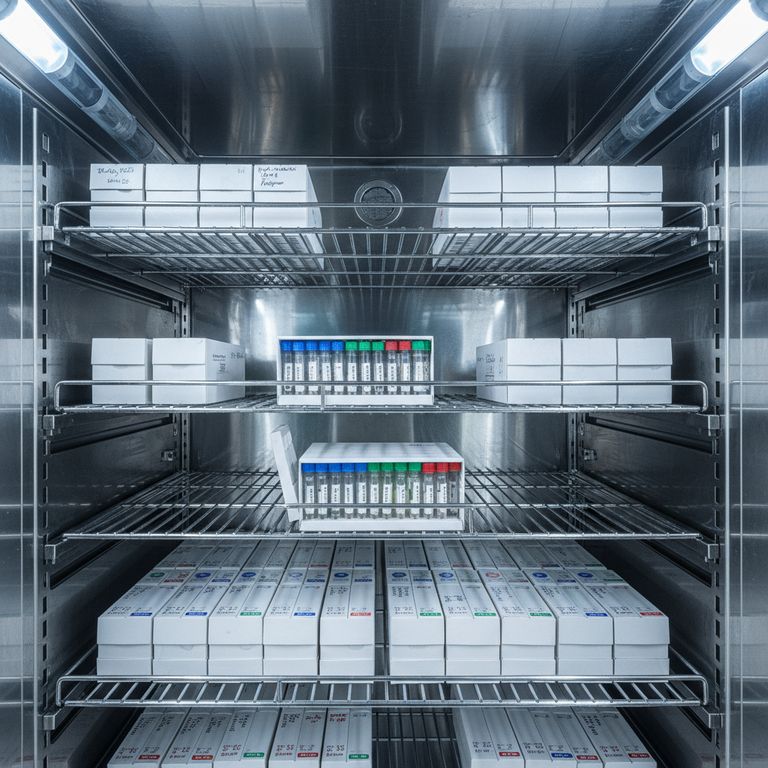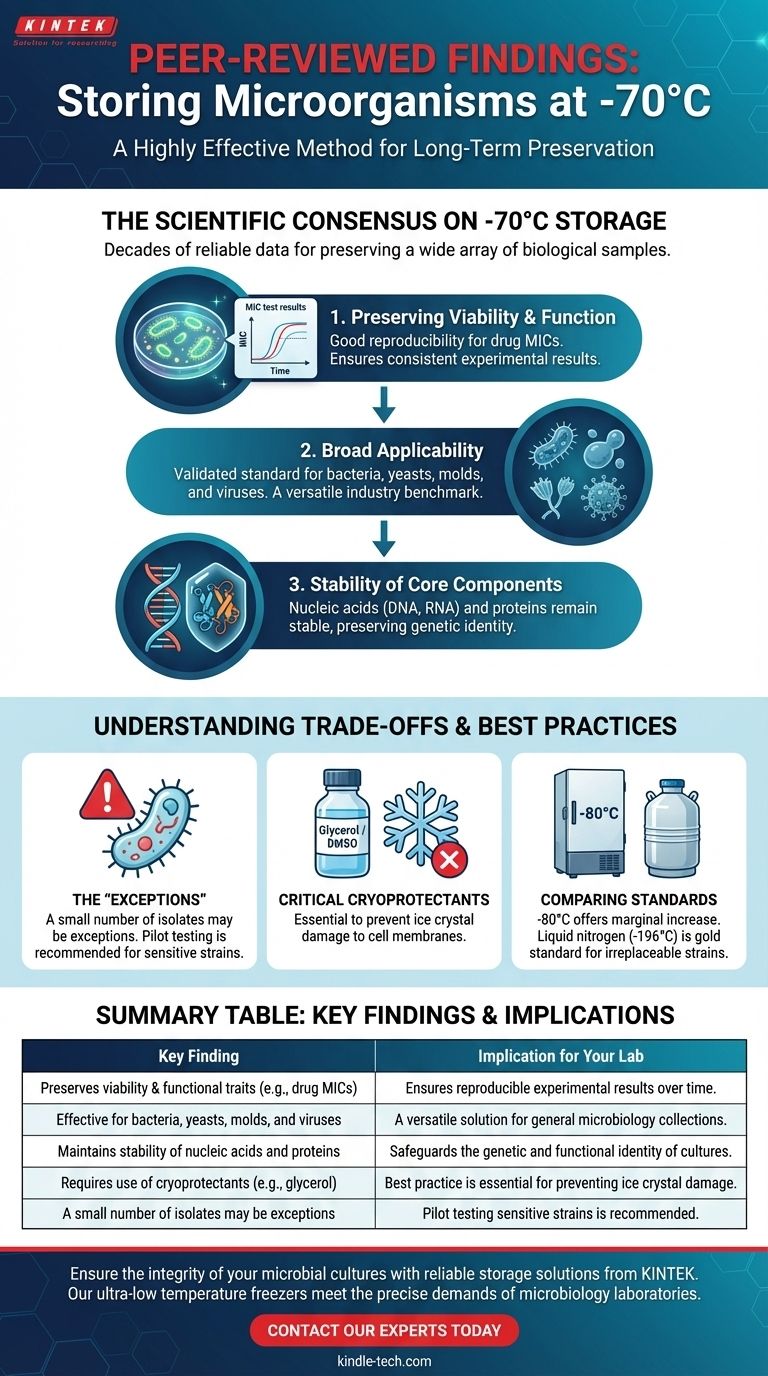Based on peer-reviewed findings, storing microorganisms at -70°C is a highly effective and widely accepted method for long-term preservation. Studies confirm that a broad range of microbes, including bacteria, yeasts, and molds, can be successfully recovered after storage at this temperature, retaining not only their viability but also key functional characteristics.
The core challenge isn't just keeping microbes alive, but ensuring they remain genetically and functionally unchanged for future experiments. Research confirms that -70°C is a robust standard that effectively halts metabolic activity, preserving the integrity of most microorganisms for extended periods.

The Scientific Consensus on -70°C Storage
For decades, ultra-low temperature freezers set to -70°C (or similar) have been a cornerstone of microbiology labs. This practice is supported by data demonstrating its reliability for preserving a wide array of biological samples.
Preserving Viability and Function
A key study demonstrated the successful recovery of yeasts and molds stored at -70°C. Critically, these recovered isolates showed good reproducibility for drug MICs (Minimum Inhibitory Concentration tests).
This finding is significant because it proves that storage at -70°C preserves not just viability but also specific functional traits, which is essential for consistent experimental results.
Broad Applicability Across Microbes
The effectiveness of -70°C storage extends beyond fungi. It is a validated standard for preserving bacteria and viruses, making it a versatile temperature for general microbiology collections.
Historically, ultra-low freezers were commonly set to -65°C or -70°C, establishing this temperature range as a reliable industry benchmark.
Stability of Core Cellular Components
The success of -70°C storage is rooted in its ability to preserve the fundamental building blocks of the cell. At this temperature, critical biomolecules like nucleic acids (DNA and RNA) and most proteins remain stable.
By preventing the degradation of these components, the genetic and functional identity of the microorganism is securely maintained.
Understanding the Trade-offs and Best Practices
While -70°C is a proven standard, achieving successful preservation requires understanding its context and limitations. It is not a universally perfect solution for every single organism or situation.
The "Small Number of Exceptions"
Even in studies reporting high success rates, researchers note that a small number of isolates can be exceptions. Not every strain or species will respond identically to the freeze-thaw cycle.
Some particularly sensitive organisms may show reduced viability upon recovery, even when stored under standard protocols. Pilot testing on a small, non-critical batch is always a prudent step.
The Critical Role of Cryoprotectants
Successful long-term storage at any ultra-low temperature is not just about the temperature itself. It almost always depends on the use of a cryoprotective agent, such as glycerol or DMSO, mixed with the culture before freezing.
These agents prevent the formation of large, sharp ice crystals that can puncture cell membranes and kill the microorganism. The positive findings from studies implicitly rely on this best practice.
Comparing -70°C to Other Standards
Modern ultra-low freezers are often set to -80°C, which offers a marginal increase in security over -70°C. For ultimate long-term preservation, especially for irreplaceable or highly sensitive cultures, storage in or over liquid nitrogen (-196°C) remains the gold standard.
How to Apply This to Your Project
Your choice of storage temperature depends on the nature of your samples and the goals of your research.
- If your primary focus is routine, long-term storage of common bacteria, yeasts, or molds: A -70°C freezer is a scientifically validated and highly reliable choice.
- If your primary focus is preserving specific functional traits (e.g., antibiotic resistance): Studies show that -70°C storage provides good reproducibility for such characteristics.
- If your primary focus is archiving irreplaceable, novel, or highly sensitive strains: Consider using vapor-phase liquid nitrogen for maximum long-term security and viability.
Ultimately, storage at -70°C is a robust and evidence-backed pillar of modern microbiology, enabling reproducible science through reliable sample preservation.
Summary Table:
| Key Finding | Implication for Your Lab |
|---|---|
| Preserves viability & functional traits (e.g., drug MICs) | Ensures reproducible experimental results over time. |
| Effective for bacteria, yeasts, molds, and viruses | A versatile solution for general microbiology collections. |
| Maintains stability of nucleic acids and proteins | Safeguards the genetic and functional identity of cultures. |
| Requires use of cryoprotectants (e.g., glycerol) | Best practice is essential for preventing ice crystal damage. |
| A small number of isolates may be exceptions | Pilot testing sensitive strains is recommended. |
Ensure the integrity of your microbial cultures with reliable storage solutions from KINTEK.
Peer-reviewed studies confirm that -70°C storage is a robust standard for preserving the viability and functional characteristics of bacteria, yeasts, and molds. Choosing the right equipment is critical for achieving these results and maintaining the reproducibility of your research.
KINTEK specializes in providing high-quality lab equipment, including ultra-low temperature freezers, to meet the precise demands of microbiology laboratories. Our solutions help you safeguard your valuable samples for the long term.
Contact our experts today to find the perfect storage solution for your laboratory's specific needs and ensure your research stands on a foundation of reliable preservation.
Visual Guide

Related Products
- 158L Precision Vertical Ultra Low Freezer for Laboratory Applications
- 938L Vertical Ultra Low Temperature Freezer for Advanced Laboratory Storage
- 108L Vertical Ultra Low Temperature ULT Freezer
- 408L Advanced Vertical Laboratory Ultra Low Temperature Freezer for Critical Research Material Preservation
- 808L Precision Laboratory Vertical Ultra Low Temperature Freezer
People Also Ask
- What makes Ultra-Low Temperature freezers energy efficient? Key Design & Operational Strategies
- What are ultra low temperature freezers used for? Preserving Critical Biological Samples for Decades
- Where are ultra low temperature freezers commonly used? Essential for Labs, Hospitals, and Biotech
- What advantages do ultra-low temperature freezers offer? Ensure Long-Term Sample Integrity and Reliability
- What are the common applications of ultra-low temperature freezers? Preserve Your Most Valuable Samples



















